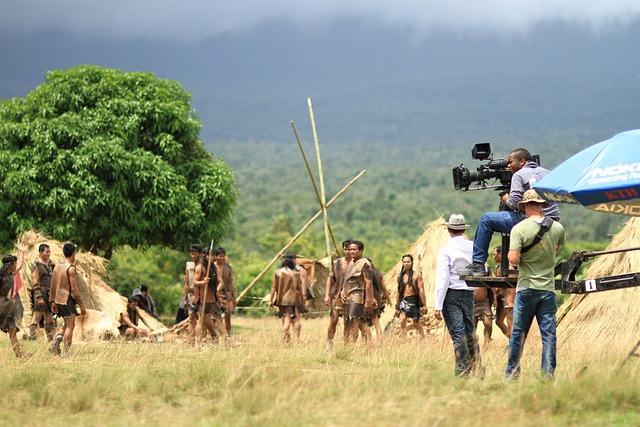In the world of cinema, where stories unfold through a dance of light and shadow, the collaboration between directors and cinematographers is akin to a symphony. Together, they craft the visual heartbeat of a film, transforming written scripts into vivid, moving tapestries. This partnership is a delicate balance of vision and technique, where directors articulate the soul of the narrative and cinematographers translate it into a visual language. Through this intricate collaboration, they create the mesmerizing images that linger in our minds long after the credits roll. Join us as we explore the dynamic interplay between these two creative forces and uncover how their combined artistry shapes the essence of visual storytelling.
Crafting the Vision: Building a Creative Partnership
In the realm of visual storytelling, the dynamic synergy between directors and cinematographers is pivotal. Together, they weave the narrative’s visual tapestry, translating script into stunning imagery. This collaboration is not merely technical but deeply creative, requiring a shared vision and mutual trust. Directors bring the story’s emotional core, while cinematographers craft its visual language, using light, composition, and camera movement to evoke emotion and enhance the narrative.
- Vision Alignment: Early discussions are crucial to align on themes, mood, and visual style.
- Storyboarding: Detailed storyboards serve as a blueprint, guiding the visual execution.
- Innovative Techniques: Experimentation with camera angles and lighting can lead to unique visual expressions.
- Continuous Dialogue: Open communication ensures adaptability and creative problem-solving on set.
Through this intricate partnership, directors and cinematographers create a visual narrative that captivates audiences, turning abstract ideas into a tangible, immersive experience.

Translating Emotion: Techniques for Visual Impact
In the art of visual storytelling, the seamless blend of emotion and imagery is crucial. Directors and cinematographers often employ a variety of techniques to ensure the emotional core of a story resonates with the audience. Through meticulous composition, they can convey the nuanced layers of a character’s journey. Lighting plays a pivotal role in setting the mood; a soft, diffused glow can evoke warmth and intimacy, while stark, high-contrast shadows might suggest tension or conflict. Similarly, the choice of color palette—from the muted tones of a somber scene to the vibrant hues of a joyful moment—guides viewers’ emotional responses.
- Camera Angles: Low angles can make characters appear powerful, while high angles might render them vulnerable.
- Framing: Tight close-ups capture subtle facial expressions, enhancing emotional intensity.
- Movement: A smooth, flowing camera can mirror a character’s tranquility, whereas jittery, handheld shots might reflect chaos or instability.
Ultimately, the synergy between director and cinematographer transforms a script into a visual tapestry, ensuring that every frame speaks volumes beyond the dialogue.

Harnessing Technology: Tools for Enhanced Storytelling
In the realm of visual storytelling, technology serves as a powerful ally for directors and cinematographers. These tools enhance their ability to craft immersive narratives that captivate audiences. With the advent of digital cameras, directors can explore a broader range of creative possibilities, from manipulating frame rates to experimenting with dynamic lighting setups. Meanwhile, drones provide breathtaking aerial shots that were once unimaginable, adding a new dimension to storytelling.
Collaboration between directors and cinematographers is further enriched by software tools like pre-visualization programs. These allow for detailed planning and visualization of scenes before shooting begins. Key benefits include:
- 3D modeling for intricate scene design
- Virtual reality simulations to explore shot compositions
- Color grading software to establish mood and tone
These technologies empower the creative partnership, enabling them to push the boundaries of what’s visually possible, ensuring every frame tells a compelling story.

Balancing Art and Budget: Strategic Planning for Visual Success
Directors and cinematographers work hand in hand to create a visually compelling narrative while staying within budget constraints. This collaboration begins with shared vision development, where both parties discuss the thematic and emotional tone of the film. By aligning on the desired visual style, they can prioritize the use of resources effectively. Whether it’s opting for natural lighting to save on equipment costs or selecting versatile locations to minimize set changes, every decision is a strategic blend of creativity and practicality.
- Storyboarding Sessions: Mapping out scenes to visualize the film’s flow and identify cost-effective techniques.
- Resource Allocation: Deciding where to invest in high-quality equipment and where to economize without compromising the artistic vision.
- Innovative Techniques: Utilizing creative solutions like digital effects or unconventional camera angles to enhance storytelling within budget.
The synergy between a director and cinematographer is crucial in making artistic decisions that are both imaginative and financially viable, ensuring the film’s visual storytelling is both impactful and economically sound.

